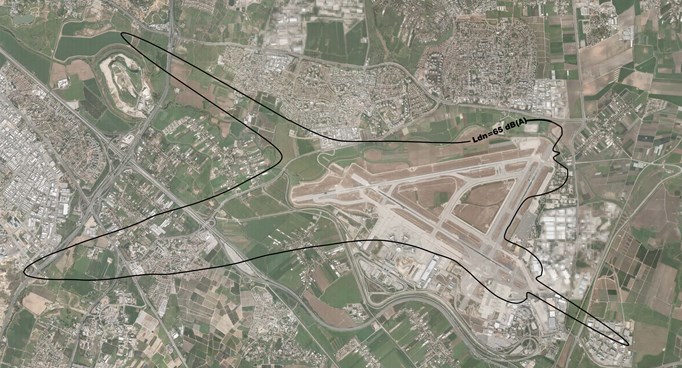National Outline Plan – Operating and Acoustic Protection Pattern
Ben Gurion Airport’s operation patterns under National Master Plan 2/4 0 results are shown
1. Operating pattern
The National Outline Plan for Ben Gurion International Airport (NOP 2/4), signed and approved in 1997, is intended to guarantee the State of Israel’s ability to integrate in global economic activity and contribute to the welfare of the country’s residents, while minimizing the injury to the environment.
NOP 2/4 is concerned not only with the issue of the structure of an airport and its facilities for both air traffic (runways, plane parking spaces, an air traffic control system) and ground traffic (passenger and cargo terminals, various vital services, access routes, et cetera) but also with arranging the coordination with the physical planning throughout the entire space affected by the aviation activity. Furthermore, the plan defines operating patterns for the airport’s aviation activity to minimize injury to the population to the greatest extent possible.
To comply with the customary criteria of flight safety and environmental protection, the airport’s operation imposes various restrictions on the uses made of the land in the entire area affected by the airport’s activity and is coordinated with the restrictions required by the airport’s operation and by the flight safety guidelines, and also regulates the aviation relationship with the environment by establishing detailed environmental guidelines in the field affected by the air and ground activity taking place in an airport.
The plan’s Environmental Array chapter defines the preferred operating pattern, acoustic treatment of existing residential structures and guidelines for following up on and monitoring the environmental guidelines’ implementation.
2. Acoustic protection
The following is a brief description of the acoustic protection plan. The plan’s binding provisions are specified in Chapter I (Sections 2 and 3) and in Annex A-5 of the NOP 2/4 BGIA outline plan.
General information:
• The technology for manufacturing quiet airplane engines has greatly developed in recent decades. Additionally, Ben Gurion International Airport takes various measures to reduce noise – such as routing planes to fly over sparsely populated areas, developing noise-minimizing takeoff procedures, using an airplane noise monitoring system and prohibiting entry into the airport to planes which do not comply with strict international criteria on noise emission.
• Despite all that, there are still areas in the airport’s vicinity which are exposed to loud noise, causing a nuisance to the residents of those areas.
• To protect the airport’s neighbors exposed to noise exceeding a certain level, a plan for acoustic protection of residential buildings is implemented, as prescribed by the airport’s outline plan – NOP 2/4. Similar plans are implemented in most international airports in the West.
• Acoustic protection significantly improves the acoustic isolation attributes of the structure’s envelope and openings and reduces the noise level inside the structure to low values. Acoustic protection is a highly effective method, despite being unpopular due to the need to close windows and use air conditioning systems – which are part of the protection plan.
Entitlement to acoustic protection
• The entitlement to acoustic protection is determined according to a blueprint of the current noise snapshot which displays the noise climate around Ben Gurion International Airport in the preceding calendar year. The blueprint, which is published every year, displays noise-equivalent curves for airplanes in a “day-night index” (Ldn) in values of 60, 65, 70 and 75 decibels.
• The outline plan defines the exact conditions entitling residential buildings to undergo acoustic treatment. The threshold level for inclusion in the treatment plan is Ldn=65dB(A). The plan includes additional conditions required to be included in it.
• The plan does not include buildings that do not have a building permit, buildings designated for evacuation or demolition and buildings which were required to be constructed with acoustic planning under a plan or permit.
Range of a curve of buildings entitled to protection

Summary of the provisions for acoustic treatment of entitled buildings
• Annex A-5 of the plan includes all the terms and provisions for performing the acoustic protection of entitled buildings.
• The actual performance of the acoustic treatment will be performed in one of the two following ways, at the entitled entity’s option:
1. The acoustic plan will be performed by the Airports Authority or representatives on its behalf, and the liability for the acoustic treatment’s planning and performance, including quality control of the work’s performance, will apply to the Airports Authority.
2. The acoustic treatment will be performed by the entitled entity or anyone on its behalf, and the liability for performing the acoustic treatment will not apply to the Airports Authority.
• The acoustic treatment will be financed by the Airports Authority and the payments to the contractors of the work will be made according to procedures to be determined by the Airports Authority.
• The acoustic planning concerns exterior doors, windows, roofs and is limited to bedrooms and living rooms. The acoustic treatment also includes the installation of air conditioners for the treated rooms.
• The precise technical specification of each entitled building will be determined by the Airports Authority and it may conduct noise measurements in the building.
• The rate of performance of the acoustic treatment of buildings will encompass at least a quarter of all entitled buildings during every calendar year, subject to the property owner’s consents and compliance with the terms.